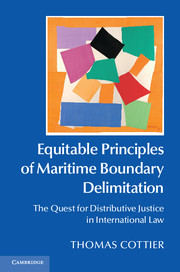 Equitable Principles of Maritime Boundary Delimitation
Equitable Principles of Maritime Boundary Delimitation Book contents
- Frontmatter
- Dedication
- Contents
- List of tables
- List of maps
- Preface
- Acknowledgements
- Table of cases
- Table of treaties and instruments
- Equity revisited: an introduction
- PART I Context: the enclosure of the seas
- 1 The silent revolution
- 2 The new maritime zones: evolution and legal foundations
- 3 Distributive effects of the enclosure movement: an assessment of global equity
- PART II The new boundaries
- PART III Delimitation based on equity
- Appendix I Maritime boundary agreements 1942–1992
- Appendix II General maps
- Bibliography
- Index
1 - The silent revolution
from PART I - Context: the enclosure of the seas
Published online by Cambridge University Press: 05 May 2015
- Frontmatter
- Dedication
- Contents
- List of tables
- List of maps
- Preface
- Acknowledgements
- Table of cases
- Table of treaties and instruments
- Equity revisited: an introduction
- PART I Context: the enclosure of the seas
- 1 The silent revolution
- 2 The new maritime zones: evolution and legal foundations
- 3 Distributive effects of the enclosure movement: an assessment of global equity
- PART II The new boundaries
- PART III Delimitation based on equity
- Appendix I Maritime boundary agreements 1942–1992
- Appendix II General maps
- Bibliography
- Index
Summary
The partition of the seas
Since the end of World War II, the law of the sea has changed profoundly. Nations began to claim jurisdiction over marine resources and to enclose parts of the globe by the end of the 1940s. Within a relatively short period of time, the traditional doctrine of ‘freedom of the high seas’ lost ground, both with regard to natural resources from the sea and seabed and for communication purposes; yet freedom of the high seas continues to prevail in principle, and freedom of navigation for ships and flight paths for aeroplanes remain unimpaired. A complex, dualistic scheme of both national and supranational jurisdiction over the non-living and living resources in the seas emerged and has continued to develop. The seas have been divided not only among different nations, but also among different and partially overlapping zones and legal regimes, with divisions now going far beyond the traditional 3-mile territorial limit of national coastal waters. The enclosure movement of the seas evolved through three successive generations of jurisdictional zones: the continental shelf; the exclusive economic zone (EEZ); and the Area. Chapter 2 will describe the first and second of these zones in more detail, while a discussion of the third follows below. The gradual extension of the territorial sea up to 12 nm and the controversial expansion of the contiguous zone are beyond the scope of this book.
Long before the great majority of newly independent countries, both developing and least developed, began gaining influence in international affairs, the legal concept of the continental shelf emerged in the 1950s. Under this concept, the coastal states were entitled to appropriate mineral resources found in the seabed of the shallow waters of the shelves. Oil and gas were the major resources that benefited these privileged states. The outer limit of the concept was not limited and followed the feasibility of technological exploitation.
- Type
- Chapter
- Information
- Equitable Principles of Maritime Boundary DelimitationThe Quest for Distributive Justice in International Law, pp. 45 - 66Publisher: Cambridge University PressPrint publication year: 2015


